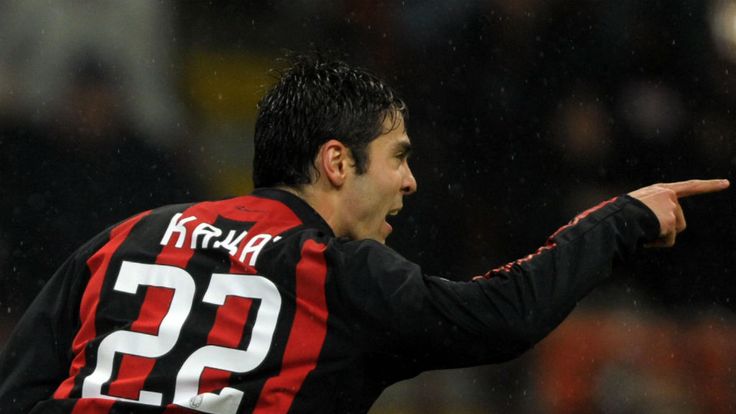The decline of Kaka
Kaka left for Real Madrid for a world record fee in 2009. He returns to AC Milan on a free transfer. Adam Bate examines the decline of a prodigious talent and wonders whether he can recapture former glories at 31

Thursday 12 September 2013 12:49, UK
Adam Bate takes a look at the Brazilian's struggles as he prepares for his AC Milan comeback.
The 2005 Champions League final will go down in history as one of the great sporting comebacks. Three goals down at the interval, Liverpool produced a remarkable revival to level things up at 3-3 against AC Milan before winning the penalty shootout. As a result, tales of Didi Hamann's half-time intervention, the Herculean efforts of Steven Gerrard and Jerzy Dudek's spaghetti legs will be the focus of after-dinner speeches on Merseyside for years to come. History is written by the winners. But the highlights reel belongs to Kaka. The bursting run leading to Andriy Shevchenko's disallowed goal makes it, as does the deliciously dinked through-ball enabling the same player to square for Hernan Crespo to double the lead. It's the third goal minutes later that really astonishes. A sway of the hips leaves Gerrard in his wake before an angled long pass cuts through the heart of the Liverpool defence. Crespo finishes. Game over. Of course, despite Kaka also netting in the shootout, there was a very different outcome and Gerrard - having caused Guardian MBM writer Barry Glendenning to wonder at half-time "how badly does he have to play before his legions of cheerleaders in the media will put down their pom-poms and pass comment on it?" - got to walk away with the man of the match award. Two years later, Milan enjoyed a revenge of sorts. Again, there was a two-goal striker to get his name in the record books. But once more, the magic came from Kaka - his measured pass to Pippo Inzaghi late in the game setting up the arch-predator for what turned out to be the winning goal. At the age of 25, Kaka belatedly had his Champions League victory. The UEFA Super Cup and FIFA Club World Cup followed later that year to go with the Serie A title he had earned in his first season with the Rossoneri. There was already a World Cup winners medal to his name, claimed as a 20-year-old talent (who saw 20 minutes of pitch action) before even leaving Sao Paulo for Europe. There were individual honours too. The Ballon d'Or in 2007 and a guaranteed place in football's hall of fame. So much so young.Record move
In 2009 came the move to Real Madrid. Despite the world record transfer fee of £56million, the dubious honour of being Real's record buy didn't even last the month. Cristiano Ronaldo joined for £80m a few weeks later. Still just 27, Kaka was ostensibly in his prime having just enjoyed his best ever goalscoring season in Serie A. Within weeks of the move he won the Golden Ball for Brazil at the Confederations Cup, being named man of the match in the final. In some ways, that was as good as his Real Madrid career got. By March in his first season at the club, he was being jeered by the Bernabeu crowd in a Champions League game against Lyon. Kaka then endured an injury-hit second season before returning to play a bit-part in the 2011/12 La Liga triumph under Jose Mourinho. Even in that successful campaign, he found himself booed throughout in a game against Malaga in the spring. So where did it go wrong? "I never had any continuity during my four years with Real Madrid," the 31-year-old Kaka said last week, although he fell some way short of blaming Mourinho for his struggles. Indeed, he seemed quite magnanimous about the whole experience, acknowledging the need for Carlo Ancelotti to take the club in a different direction. Perhaps there is an awareness that he has been complicit in his failure to meet the vast expectations. For Kaka is visibly a different player today. The languid style and sureness of touch remains. But where once the loping stride was accompanied by the pace to glide away from opponents, the way he had against Gerrard in Istanbul, there is now a sturdier frame to haul around the field. And besides, in Football Manager terms, Kaka was always more deep-lying forward than advanced playmaker. Of course, the ability to play those killer balls was in his armory. But what few had realised was how quite how dependent upon pace those qualities were. The statistics from his time in Madrid show that those dribbles have become a rarer sight with each passing year. It was his pace that allowed him to dribble so effectively. It was his pace that allowed him to play.| Kaka decline at Real Madrid | ||
| Season | Key passes per 90 | Dribbles per 90 |
| 2009/10 | 3.21 | 1.63 |
| 2010/11 | 2.88 | 1.55 |
| 2011/12 | 2.48 | 1.17 |
| 2012/13 | 2.33 | 1.12 |

